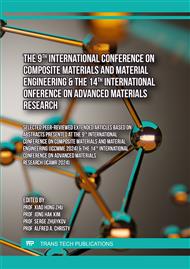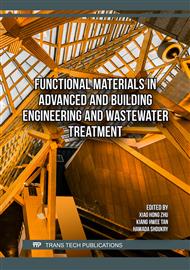[1]
Zeyad, A.M. and A. Almalki, Influence of mixing time and superplasticizer dosage on self-consolidating concrete properties. Journal of Materials Research and Technology, (2020). Vol. 9(3): pp.6101-6115.
DOI: 10.1016/j.jmrt.2020.04.013
Google Scholar
[2]
EFCAA, The European Guidelines for Self-Compacting Concrete, Specification, Production and Use. (2005).
Google Scholar
[3]
Wasim, M., Abadel, A., Bakar, B. A., & Alshaikh, I. M., Future directions for the application of zero carbon concrete in civil engineering–a review. Case Studies in Construction Materials, (2022). Vol. 17: p. e01318.
DOI: 10.1016/j.cscm.2022.e01318
Google Scholar
[4]
Kumar, M.S.K. and R. Nayak, Experimental study on utilization of industrial wastes (red mud and copper slag) in mortar. International Journal of Engineering–on line, (2015). Vol. 3(4): pp.204-208.
Google Scholar
[5]
Rathod, R.R., N.T. Suryawanshi, and P.D. Memade, Evaluation of the properties of red mud concrete. IOSR Journal of Mechanical and Civil Engineering, (2013). Vol. 1: pp.31-34.
Google Scholar
[6]
Aslani, F. and S. Nejadi, Creep and shrinkage of self-compacting concrete with and without fibers. Journal of Advanced Concrete Technology, (2013). Vol. 11(10): pp.251-265.
DOI: 10.3151/jact.11.251
Google Scholar
[7]
Borhan, T.M., M.A. Dhaheer, and Z.A. Mahdi, Characteristics of sustainable self-compacting concrete reinforced by fibres from waste materials. Arabian Journal for Science and Engineering, (2020). Vol. 45: pp.4359-4367.
DOI: 10.1007/s13369-020-04460-3
Google Scholar
[8]
Karimipour, A. and M. Ghalehnovi, Influence of steel fibres on the mechanical and physical performance of self-compacting concrete manufactured with waste materials and fillers. Construction and Building Materials, (2021). Vol. 267: p.121806.
DOI: 10.1016/j.conbuildmat.2020.121806
Google Scholar
[9]
Magbool, H.M. and A.M. Zeyad, The effect of varied types of steel fibers on the performance of self-compacting concrete modified with volcanic pumice powder. Materials Science-Poland, (2021). Vol. 39(2): pp.172-187.
DOI: 10.2478/msp-2021-0016
Google Scholar
[10]
ASTM-C33, Standard Specification for Concrete Aggregates. (2016), American Society for Testing and Materials.: West Conshohocken, PA, United States.
Google Scholar
[11]
ASTM-C618, Standard Specification for Coal Fly Ash and Raw or Calcined Natural Pozzolan for Use in Concrete. (2015), American Society for Testing and Materials.: West Conshohocken, PA, United States.
DOI: 10.1520/c0618-15
Google Scholar
[12]
ACI-211, Standard Practice for Selecting Proportions for Normal, Heavyweight and Mass Concrete. (1991), American Society for Testing and Materials.: West Conshohocken, PA, United States.
Google Scholar
[13]
ASTM-C39, Standard test method for Compressive Strength of Cylindrical Concrete Specimens. (2015a), American Society for Testing and Materials.: West Conshohocken, PA, United States.
Google Scholar
[14]
ASTM-C496, Standard test method for Splitting Tensile Strength of Cylindrical Concrete Specimens. (2011), American Society for Testing and Materials.: West Conshohocken, PA, United States.
Google Scholar
[15]
RILEM, TC50-FMC, Fracture mechanics of concrete, in: Determination of Fracture Energy of Mortar and Concrete by Means of Three Point Bend Tests on Notched Beams,Draft RILEM Recommendation. Materials and Structures, (1985). Vol.18((106)): p.285–290.
DOI: 10.1007/bf02498757
Google Scholar
[16]
Karihaloo, B.L., Fracture Mechanics & Structural Concrete. Longman Scientific and Technical, (1995).
Google Scholar
[17]
Reda Taha, M. M., El-Dieb, A. S., Abd El-Wahab, M. A., & Abdel-Hameed, M. E., Mechanical, fracture, and microstructural investigations of rubber concrete. Journal of materials in civil engineering, (2008). Vol. 20(10): pp.640-649.
DOI: 10.1061/(asce)0899-1561(2008)20:10(640)
Google Scholar
[18]
Al-Tayeb, M. M., Abu Bakar, B. H., Akil, H. M., & Ismail, H., Effect of partial replacements of sand and cement by waste rubber on the fracture characteristics of concrete. Polymer-Plastics Technology and Engineering, (2012). Vol. 51(6): pp.583-589.
DOI: 10.1080/03602559.2012.659307
Google Scholar
[19]
Alwesabi, E. A., Bakar, B. A., Alshaikh, I. M., Zeyad, A. M., Altheeb, A., & Alghamdi, H., Experimental investigation on fracture characteristics of plain and rubberized concrete containing hybrid steel-polypropylene fiber. Structures, (2021). Vol. 33: pp.4421-4432).
DOI: 10.1016/j.istruc.2021.07.011
Google Scholar
[20]
Zeyad, A.M., Effect of fibers types on fresh properties and flexural toughness of self-compacting concrete. Journal of Materials Research and Technology, (2020). Vol. 9(3): pp.4147-4158.
DOI: 10.1016/j.jmrt.2020.02.042
Google Scholar
[21]
Abdullah, G. M., Alshaikh, I. M., Zeyad, A. M., Magbool, H. M., & Bakar, B. A., The effect of openings on the performance of self-compacting concrete with volcanic pumice powder and different steel fibers. Case Studies in Construction Materials, (2022). Vol. 17: p. e01148.
DOI: 10.1016/j.cscm.2022.e01148
Google Scholar
[22]
Alshaikh, I. M., Abu Bakar, B. H., Alwesabi, E. A., Abadel, A. A., Alghamdi, H., & Wasim, M., An experimental study on enhancing progressive collapse resistance using a steel fiber–reinforced concrete frame. Journal of Structural Engineering, (2022). Vol. 148(7): p.04022087.
DOI: 10.1061/(asce)st.1943-541x.0003327
Google Scholar
[23]
Alwesabi, E. A., Bakar, B. A., Alshaikh, I. M., & Akil, H. M., Impact resistance of plain and rubberized concrete containing steel and polypropylene hybrid fiber. Materials Today Communications, (2020). Vol. 25: p.101640.
DOI: 10.1016/j.mtcomm.2020.101640
Google Scholar
[24]
Alwesabi, E. A., Bakar, B. A., Alshaikh, I. M., & Akil, H. M., Experimental investigation on mechanical properties of plain and rubberised concretes with steel–polypropylene hybrid fibre. Construction and Building Materials, (2020). Vol. 233: p.117194.
DOI: 10.1016/j.conbuildmat.2019.117194
Google Scholar
[25]
Mo, K. H., Yap, K. K. Q., Alengaram, U. J., & Jumaat, M. Z., The effect of steel fibres on the enhancement of flexural and compressive toughness and fracture characteristics of oil palm shell concrete. Construction and Building Materials, (2014). Vol. 55: pp.20-28.
DOI: 10.1016/j.conbuildmat.2013.12.103
Google Scholar
[26]
Tschegg, E. K., Schneemayer, A., Merta, I., & Rieder, K. A., Energy dissipation capacity of fibre reinforced concrete under biaxial tension–compression load. Part II: Determination of the fracture process zone with the acoustic emission technique. Cement and Concrete Composites, (2015). Vol. 62: pp.187-194.
DOI: 10.1016/j.cemconcomp.2015.07.003
Google Scholar
[27]
Wang, Z., J. Gou, and D. Gao, Experimental study on the fracture parameters of concrete. Materials, (2021). Vol. 14(1): p.129.
Google Scholar



